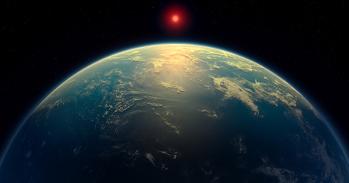
Astronomers have made a record-breaking measurement of a black hole’s spin, one of two fundamental properties of black holes. NASA’s Chandra X-ray Observatory shows this black hole is spinning slower than most of its smaller cousins. This is the most massive black hole with an accurate spin measurement and gives hints about how some of the universe’s biggest black holes grow.
Astronomers have made a record-breaking measurement of a black hole’s spin, one of two fundamental properties of black holes. NASA’s Chandra X-ray Observatory shows this black hole is spinning slower than most of its smaller cousins. This is the most massive black hole with an accurate spin measurement and gives hints about how some of the universe’s biggest black holes grow.
The moderate spin for this ultramassive object may be a testament to the violent, chaotic history of the universe’s biggest black holes
James Matthews
Supermassive black holes contain millions or even billions of times more mass than the Sun. Astronomers think that nearly every large galaxy has a supermassive black hole at its center. While the existence of supermassive black holes is not in dispute, scientists are still working to understand how they grow and evolve. One critical piece of information is how fast the black holes are spinning.
“Every black hole can be defined by just two numbers: its spin and its mass,” said Julia Sisk-Reynes of Cambridge's Institute of Astronomy (IoA), who led the study, published in the Monthly Notices of the Royal Astronomical Society. “While that sounds fairly simple, figuring those values out for most black holes has proved to be incredibly difficult.”
For this result, researchers observed X-rays that bounced off a disk of material swirling around the black hole in a quasar known as H1821+643. Quasars contain rapidly growing supermassive black holes that generate large amounts of radiation in a small region around the black hole. Located in a cluster of galaxies about 3.4 billion light-years from Earth, H1821+643’s black hole is between about three and 30 billion solar masses, making it one of the most massive known. By contrast, the supermassive black hole in the center of our galaxy weighs about four million Suns.
The strong gravitational forces near the black hole alter the intensity of X-rays at different energies. The larger the alteration the closer the inner edge of the disk must be to the point of no return of the black hole, known as the event horizon. Because a spinning black hole drags space around with it and allows matter to orbit closer to it than is possible for a non-spinning one, the X-ray data can show how fast the black hole is spinning.
“We found that the black hole in H1821+643 is spinning about half as quickly as most black holes weighing between about a million and ten million suns,” said co-author Professor Christopher Reynolds, also of the IoA. “The million-dollar question is: why?”
The answer may lie in how these supermassive black holes grow and evolve. This relatively slow spin supports the idea that the most massive black holes like H1821+643 undergo most of their growth by merging with other black holes, or by gas being pulled inwards in random directions when their large disks are disrupted.
Supermassive black holes growing in these ways are likely to often undergo large changes of spin, including being slowed down or wrenched in the opposite direction. The prediction is therefore that the most massive black holes should be observed to have a wider range of spin rates than their less massive relatives.
On the other hand, scientists expect less massive black holes to accumulate most of their mass from a disk of gas spinning around them. Because such disks are expected to be stable, the incoming matter always approaches from a direction that will make the black holes spin faster until they reach the maximum speed possible, which is the speed of light.
“The moderate spin for this ultramassive object may be a testament to the violent, chaotic history of the universe’s biggest black holes,” said co-author Dr James Matthews, also of the IoA. “It may also give insights into what will happen to our galaxy’s supermassive black hole billions of years in the future, when the Milky Way collides with Andromeda and other galaxies.
This black hole provides information that complements what astronomers have learned about the supermassive black holes seen in our galaxy and in M87, which were imaged with the Event Horizon Telescope. In those cases, the black hole’s masses are well known, but the spin is not.
NASA's Marshall Space Flight Center manages the Chandra program. The Smithsonian Astrophysical Observatory's Chandra X-ray Center controls science operations from Cambridge, Massachusetts, and flight operations from Burlington, Massachusetts.
Reference:
Júlia Sisk-Reynés et al. 'Evidence for a moderate spin from X-ray reflection of the high-mass supermassive black hole in the cluster-hosted quasar H1821+643.' Monthly Notices of the Royal Astronomical Society (2022). DOI: 10.1093/mnras/stac1389
Adapted from a Chandra press release.

The text in this work is licensed under a Creative Commons Attribution 4.0 International License. Images, including our videos, are Copyright ©University of Cambridge and licensors/contributors as identified. All rights reserved. We make our image and video content available in a number of ways – as here, on our main website under its Terms and conditions, and on a range of channels including social media that permit your use and sharing of our content under their respective Terms.




